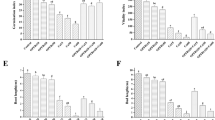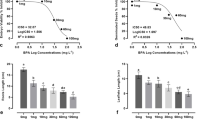Abstract
Seeds of Zea mays L. were exposed to aflatoxine B1 (AFB1), aflatoxine G1 (AFG1) and selenium (Se) alone and in combination and allowed to germinate. Phytohormone levels of GA-like substances (GAs), trans-Zeatin (t-Z) and Indole-3-acetic acid (IAA) were determined by High Performance Liquid Chromatography (HPLC) when the roots of the germinating seeds reach 1.5–3.0 cm in length. The levels of endogenous hormones decreased in seeds treated with AFB1 and AFG1 compared to control; however an increase was noted in seeds exposed to AFG1 and Se together. AFB1 and Se treatment caused reduced hormone levels in most of the treatments. When plants were exposed to Se alone, the highest levels of GAs, t-Z and IAA were observed in the application of 800 ppm Se. The highest levels of GAs, t-Z and IAA were observed when seeds were treated with 0.2 ppm AFG1 + 8 ppm Se, 0.2 ppm AFG1 + 8 ppm Se and 0.2 ppm AFG1 + 0.08 ppm Se, respectively, whereas the lowest levels of the hormones were observed in 0.2 ppm AFB1 + 8 ppm Se, 0.2 ppm AFB1 + 0.08 ppm Se and 0.1 ppm AFB1, respectively. In conclusion, the levels of phytohormones were reduced by the treatment of AFB1 and AFG1 alone. However Se removed the negative effect of AFB1 on phytohormones, but not AFB1.






Similar content being viewed by others
References
Abdou RF, Megella SE, Azab SG (1984) Mutogenic effect of aflatoxin B1 and G1 on the Egyptian cotton leaf-worm Spodoptera littoralis (Boisd). Mycopathologia 88:23–26
Ahmad SK (1993) Mycoflora changes and aflatoxin production in stored blackgram seeds. J Stored Prod Res 29:33–36
Anderson HW, Nehring EW, Wichser WR (1975) Aflatoxin contamination of corn in the field. J Agric Food Chem 23:775–782
Andresen I, Becker W, Schluter K, Burges J, Parthier B (1992) The identification of leaf thionin as one of the main jasmonate-induced proteins of barley (Hordeum Vulgare). Plant Mol Biol 19:193–204
Bathnagar D, Garcia S (2001) Aspergillus. In: Labbe RG, Garcia S (eds) Guide to foodborne pathogens. John Wiley and Sons, New York, pp 35–49
Battal P, Aslan A, Turker M, Uzun Y (2004) The effect of gaseous air pollutant sulfur dioxide on phytohormone levels in some lichens. Fresinus Environ Bull 13(5):436–440
Bell E, Mullet JE (1991) Lipoxygenase gene expression is modulated in plants by water deficit, wounding, and methyl jasmonate. Mol Gen Genet 230:456–462
Bilgrami KS, Sinha KK (1992) Aflatoxins their biological effects and ecological significance. In: Bhatnager D, Lillehoj EB, Arora DK (eds) Handbook of applied mycology, vol 5. Marcel Dekker, New York, pp 59–86
Biswas S, Talukder G, Sharma A (1997) Selenium, salts and chromosome damage. Mutat Res 390:201–205
Busley WF, Wogan GN (1979) Food-borne mycotoxins and alimeniary mycotoxicosis. In: Reiman HP, Bryan FL (eds) Food-borne infections and intoxications, 2nd edn. Academic Press, New York, pp 519–610
Cakmak I, Marschner H, Bangert F (1989) Effect of zinc nutritional status on growth, protein metabolism and levels of indole-3-acetic acid and other phytohormones in bean (Phaseolus vulgaris L.). J Exp Bot 40:404–412
Chen J, Goetchius MP, Campbell TC, Combs GFJR (1982a) Effects of dietary selenium and vitamin E on hepatic mixed-function oxidase activities and in vivo covalent binding of aflatoxin B1 in rats. J Nutr 112:324–349
Chen J, Goetchius MP, Combs GFJR, Campbell TC (1982b) Effects of dietary selenium and vitamin E on covalent binding of aflatoxin to chick liver cell macromolecules. J Nutr 112:350–355
Chow CK, Gairola GC (1984) Influence of dietary vitamin E and selenium on metabolic activation of chemicals to mutagens. J Agric Food Chem 32:443–447
Combs GFJR (1997) Selenium and cancer. In: Garewal H (ed) Antioxidants and disease prevention. CRC Press, New York, pp 97–113
Creelman RA, Tierney ML, Mullet JE (1992) Jasmonic acid/methyl jasmonate accumulate in wounded soybean hypocotyls and modulate wound gene expression. Proc Natl Acad Sci USA 89:4938–4941
Dashek WV, Llewellyn GC (1983) Mode of action of the hepatocarcinogens, aflatoxins in plant systems: a review. Mycopatologia 81:83–94
El-Bayoumy K (2001) The protective role of selenium on genetic damage and on cancer. Mutat Res 475:123–139
El-Naghy MA, Fadl-Allah EM, Samhan M (1999) Effects of Aflotoxin G1 on germination, growth and metabolic activities of some crop plants. Cytobiosis 97:87–93
Farmer EE, Ryan CA (1992) Octadecanoid precursors of jasmonic acid activate the synthesis of woundinducible proteinase inhibitors. Plant Cell 4:129–134
Ferguson LR, Philpott M (2004) Dietary cancer and prevention using antimutagens. Toxicology 198:147–159
Fujioka S, Sakurai A, Yamaguchi I, Murofiishi N, Takahashi N, Kaihari S, Takimota A, Cleland CF (1986) Flowering and Endogenous levels of plant hormones in Lemna species. Plant Cell Physiol 27:151–160
Gerald F, Combs GFJR, William PG (1998) Chemopreventive agents: selenium. Pharmacol Ther 79:179–192
Gourama H, Bullerman LB (1995) Antimycotic and antiaflatoxigenic effect of lactic acid bacteria a review. J Food Protect 57:1275–1280
Gqaleni N, Smith JE, Lacey J (1996) Co-production of aflatoxins and cyclopiazonic acid in isolates of Aspergillus flavus. Food Addit Contam 13:677–685
Groopman JP, Croy RG, Wogan GN (1981) In vitro reactions of aflatoxin B1 aducted DNA. Proc Natl Acad Sci USA 78:5445–5449
Gundlach H, Muller MJ, Kutchan TM, Zenk MH (1992) Jasmonic acid is a signal transducer in elicitor-induced plant cell structures. Proc Natl Acad Sci USA 89:2389–2393
Hamilton SJ (1999) Hypothesis of historical effects from selenium on endangered fish in the Colorado River Basin. Hum Ecol Risk Assess 5:1153–1180
Hela K, Cardwell K, Setamou FM, Phoehlig HM (2000) The influence of storage practices on aflatoxin contamination in maize in four agroecological zones of Benin, west Africa. J Stored Prod Res 36:365–382
Hsieh DPH, Wong ZA, Wong JJ, Michas C, Ruebner BH (1977) Comparative metabolism of aflatoxin. In: Rodricks JV, Hesseltine CW, Mehlman MA (eds) Mycotoxins in human and animal health. Pathotox Publishers, Park Forest South, pp 37–50
Hodson PV, Hilton JW (1983) The nutritional requirements and toxicity to fish of dietary and waterborne selenium. Ecol Bull (Stockholm) 35:335–340
Kuraishi S, Tasaki K, Sakurai N, Sadatoku K (1991) Changes in levels of cytokinins in etiolated squash seedlings after illumination. Plant Cell Physiol 2:585–591
Lemly AD (1985) Toxicology of selenium in a freshwater reservoir: implications for environmental hazard evaluations and safety. Ecotoxicol Environ Saf 10:314–338
Leontopoulos D, Siafaka A, Markaki P (2003) Black olives as substrate for Aspergillus parasiticus growth and aflatoxin B1 production. Food Microbiol 20:119–126
Lillehoj EB, Zuber MS (1988) Distribution of toxin-producing fungi in mature maize kernels from diverse environments. Trop Sci 28:19–24
Lutz C (1994) The functioning of the maize market in Benin: spatial and temporal arbitrage on the market of a staple food crop. PhD Thesis, University of Amsterdam
Machackova L, Krekule J, Seidlova F, Strnad M (1993) Cytokinins in photoperiodic introduction of flowering Chenopodium species. Physiol Plant 87:160–166
McLean M, Watt MP, Berjak P, Dutton MF 1995. Aflatoxine B1-its effects on an in vitro plant system. Food Addit Contam 12(3):435–443
Ong T (1971). Mutogenic activities of aflatoxins B1 and G1 in Neurospora crassa. Mol Gen Genet 111:159–160
Presser TS, Ohlendorf HM (1987) Biogeochemical cycling of selenium in the San Joaquin Valley. Environ Manage 11:805–821
Rayman MP (2000) The importance of selenium to human health (review). Lancet 356:233–241
Reis J (1978) Effects of mycotoxins on higher plants, algae, fungi and bacteria. In: Wyllie D, Morehouse LG (eds) Mycotoxic fungi, mycotoxins, mycotoxicoses: an encylopaedic handbook mycotoxicoses of man and plants: mycotoxin control and regulatory Practices. Marcel Dekker Inc, New York, pp 119–143
Schrauzer GN, White DA, Schneider CJ (1977) Cancer mortality correlation studies-III: statistical associations with dietary selenium intakes. Bioinorg Chem 7:23–31
Sembdener G, Parthier B (1993) The biochemistry and the physiological and molecular actions of jasmonates. Annu Rev Plant Physiol 44:569–589
Shi CY, Chua SC, Lee HP, Ong CN (1994) Inhibition of aflatoxin B1-DNA binding and adduct formation by selenium in rats. Cancer Lett 82:203–208
Skorupa JP (1998) Selenium poisoning of fish and wildlife in nature: lessons from twelve real-world examples. In: Frankenberger W, Engberg RA (eds) Environmental chemistry of selenium. Marcel Dekker, New York, pp 315–354
Spallholz JE (1994) On the nature of selenium toxicity and carcinostatic activity. Free Rad Biol Med 17:45–64
Wang Q, Little CHA, Sheng CO, Pharis RP (2002) Effect of exogenous gibberellin A4/7 on tracheid production, longitudinal growth and the levels of indole-3-acetic acid and gibberellins A4, A7 and A9 in terminal shoot of Pinus sylvestris seedlings. Physiol Plant 86:202–208
Wilbur COG (1983) Selenium – A potential environmental poison and a necessary food constituent. Springfield, IL, pp 134
Wogan GN (1992) Aflatoxins as risk factors for hepatocellular carcinoma in humans. Cancer Res 52:2114–2118
Zeringue HJ (2002) Effects of methyl jasmonate on phytoalexin production and aflatoxin control in the developing cotton boll. Biochem System Ecol 30:497–503
Author information
Authors and Affiliations
Corresponding author
Rights and permissions
About this article
Cite this article
Ağar, G., Türker, M., Battal, P. et al. Phytohormone levels in germinating seeds of Zea mays L. exposed to selenium and aflatoxines. Ecotoxicology 15, 443–450 (2006). https://doi.org/10.1007/s10646-006-0079-z
Accepted:
Published:
Issue Date:
DOI: https://doi.org/10.1007/s10646-006-0079-z




